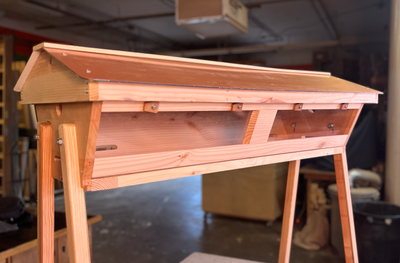Langstroth Hive Management
How to manage a langstroth hive
BEE INSTALLATION
To install a bee package in a Langstroth hive, we recommend starting with either 2 deep boxes, or 3 medium boxes. With 2 deeps, include frames in the bottom box, and not in the top. With 3 mediums, include frames in the bottom 2 boxes, and not in the top. Remove the cap from the queen cage exposing the hard candy, and place the cage on top of the frames. Shake the bees into the empty top box, and place the package near the entrance for stragglers to move in on their own. Replace the frames in the top box, then set the inner cover and telescoping outer cover to close off top of the hive. Swarms can be installed with the same box configuration without needing to place the queen cage.
MAINTENAnCE HIVE CHECKS
Langstroth hives don't require an overwhelming amount of maintenance. The main tasks involved with hive maintenance include expanding the hive in the spring and removing boxes after honey harvest in the fall. Honeybees require a delicate balance of space. If the bees have too little space, they will likely swarm. If they have too much empty space in the hive, they will overwork themselves, and likely abscond. If the colony has filled out their comb in late spring, adding an additional box could prevent swarming.
When keeping bees in a Langstroth hive, you can choose to expand the hive for a growing colony in 2 ways: Supering (adding boxes to the top of the hive) or Nadiring (adding boxes to the bottom of the hive).
1) Supering
This is the method of expanding a hive by adding boxes to the top. These boxes are called supers. As the colony grows, the beekeeper adds supers for honey storage. The queen will keep her brood nest in the region of the hive closest to the entrance at the bottom of the hive. That way, when the colony moves toward their honey stores in the winter, they are further away from cold air coming through the entrance. Thus, by supering, you are giving the bees space to store honey. Brood boxes stay in place on the bottom of the hive, and are most commonly 2 deep boxes. Medium boxes are commonly used for honey supers.
2) Nadiring
Nadiring is the practice of expanding a Langstroth hive by adding empty boxes to the bottom. This is a more natural way for bees to expand, since in nature they build comb from the top down in their hive cavity. Nadiring is best done with all medium box configuration. When the bees are nearly out of space, add an empty box to the bottom. The bees will make fresh comb, and the queen will move down to lay eggs in the fresh wax near the hive entrance. Boxes with wax that once contained brood will move up, and the bees will use this comb to store honey. Full honey boxes are harvested off the top.
Honey Harvest
When harvesting from a Langstroth hive, it's not absolutely necessary to clear the bees out beforehand if you're harvesting frame by frame. Just remove one frame at a time, gently brush the bees off using a bee brush, and cut the comb from the edges of the frame (our Ultimate Hive Tool is great for this). Then, crush the comb and strain using a mesh bag. Alternately, you can make a bucket strainer system, using food grade buckets.
If you want to harvest an entire box, you will want to clear the bees from the honey super. You can do this by using a bee escape board. Place the board between the honey supers and the boxes you'd like to leave for the bees. Wait a couple days, especially as nights are getting cooler, and the bees will gradually move out of the supers, unable to find their way back up through the escape.
You can then remove the honey super from the hive, take out the frames, and follow the same instructions as above, cutting the comb, crushing it and straining it through a mesh bag.
Note: We don’t recommend harvesting any honey in the first season, instead you should leave all of it for the bees and hope for a surplus next season!
OVERWINTERING
There are a few ways to prepare your bees for winter when using a Langstroth hive.
The first is using an entrance reducer. Simply fit it in the entrance of your hive to reduce cold air coming in.
If you’re using a screened bottom board, you’ll want to close it up, or trade it out with a solid bottom board.
You can add a Langstroth Insulation Box (or quilt box) to the top of your hive, just below the telescoping cover. Quilt boxes regulate heat and humidity levels within the hive by wicking moisture up to be absorbed by wood shavings (or toe).
If you live in a high wind area, you might want to consider further securing your hives. As bees eat through their winter honey stores, the hives will become lighter and lighter. Some beekeepers use cinder blocks and ratchet straps around their hives if they are concerned, and some use hay bales to create a wind break. Find our what local beeks do in your area!





